KIA Optima 2010 3.G User Guide
Manufacturer: KIA, Model Year: 2010, Model line: Optima, Model: KIA Optima 2010 3.GPages: 336, PDF Size: 6.46 MB
Page 11 of 336
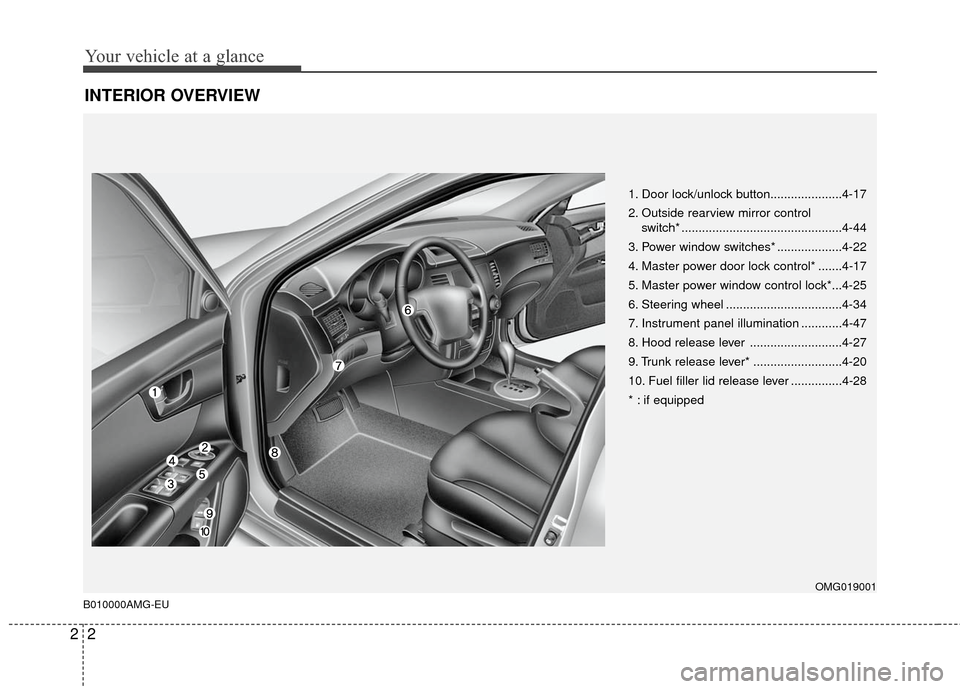
Your vehicle at a glance
22
INTERIOR OVERVIEW
B010000AMG-EU
1. Door lock/unlock button.....................4-17
2. Outside rearview mirror control switch* ...............................................4-44
3. Power window switches* ...................4-22
4. Master power door lock control* .......4-17
5. Master power window control lock*...4-25
6. Steering wheel ..................................4-34
7. Instrument panel illumination ............4-47
8. Hood release lever ...........................4-27
9. Trunk release lever* ..........................4-20
10. Fuel filler lid release lever ...............4-28
* : if equipped
OMG019001
Page 12 of 336
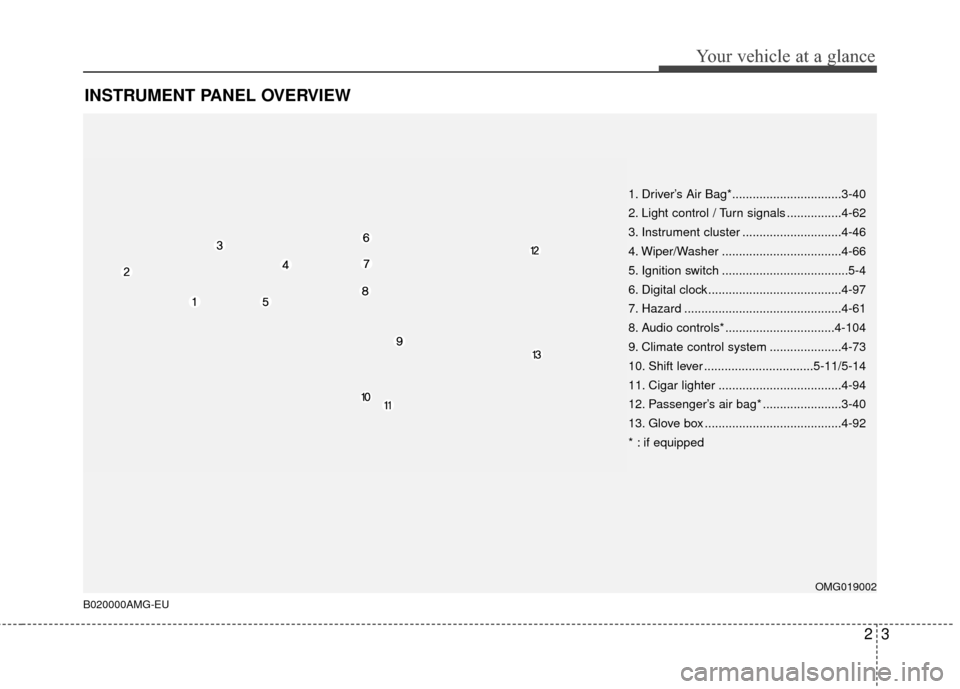
23
Your vehicle at a glance
INSTRUMENT PANEL OVERVIEW
B020000AMG-EU
OMG019002
1. Driver’s Air Bag*................................3-40
2. Light control / Turn signals ................4-62
3. Instrument cluster .............................4-46
4. Wiper/Washer ...................................4-66
5. Ignition switch .....................................5-4
6. Digital clock .......................................4-97
7. Hazard ..............................................4-61
8. Audio controls* ................................4-104
9. Climate control system .....................4-73
10. Shift lever ................................5-11/5-14
11. Cigar lighter ....................................4-94
12. Passenger’s air bag* .......................3-40
13. Glove box ........................................4-92
* : if equipped
Page 13 of 336
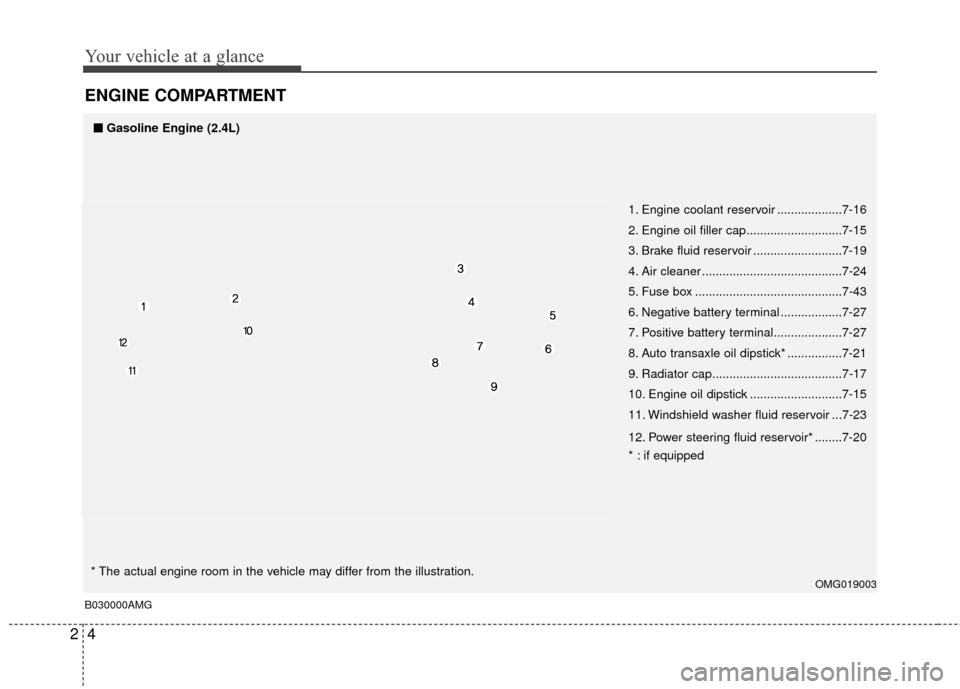
Your vehicle at a glance
42
ENGINE COMPARTMENT
B030000AMG
OMG019003
■
■Gasoline Engine (2.4L)
1. Engine coolant reservoir ...................7-16
2. Engine oil filler cap............................7-15
3. Brake fluid reservoir ..........................7-19
4. Air cleaner .........................................7-24
5. Fuse box ...........................................7-43
6. Negative battery terminal ..................7-27
7. Positive battery terminal....................7-27
8. Auto transaxle oil dipstick* ................7-21
9. Radiator cap......................................7-17
10. Engine oil dipstick ...........................7-15
11. Windshield washer fluid reservoir ...7-23
12. Power steering fluid reservoir* ........7-20
* : if equipped
* The actual engine room in the vehicle may differ from the illustration.
Page 14 of 336
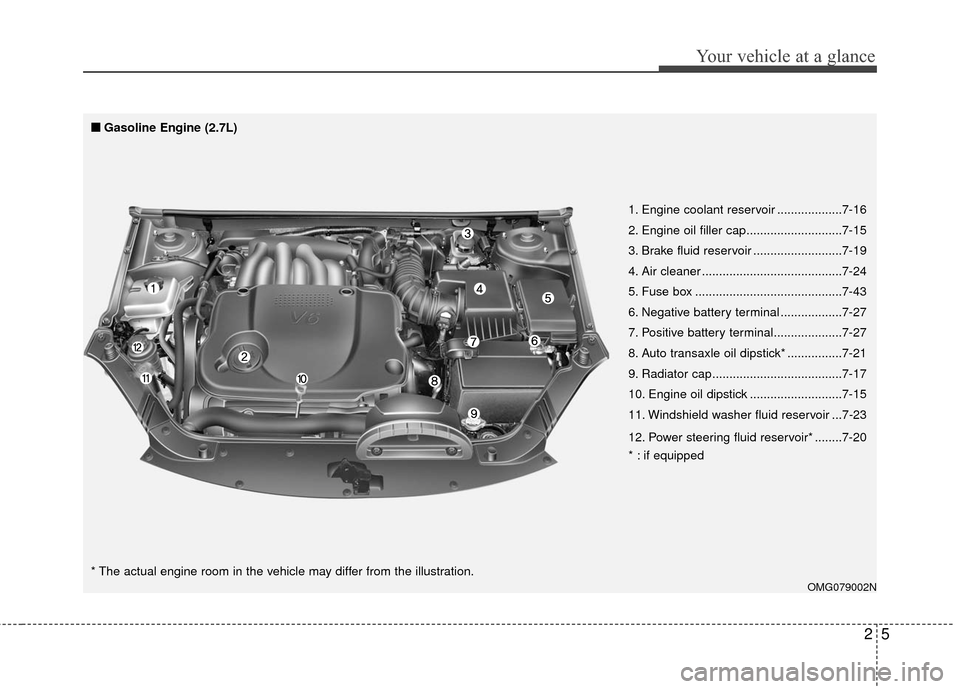
25
Your vehicle at a glance
OMG079002N
1. Engine coolant reservoir ...................7-16
2. Engine oil filler cap............................7-15
3. Brake fluid reservoir ..........................7-19
4. Air cleaner .........................................7-24
5. Fuse box ...........................................7-43
6. Negative battery terminal ..................7-27
7. Positive battery terminal....................7-27
8. Auto transaxle oil dipstick* ................7-21
9. Radiator cap......................................7-17
10. Engine oil dipstick ...........................7-15
11. Windshield washer fluid reservoir ...7-23
12. Power steering fluid reservoir* ........7-20
* : if equipped
■ ■
Gasoline Engine (2.7L)
* The actual engine room in the vehicle may differ from the illustration.
Page 15 of 336

3
Seats / 3-2
Seat belts / 3-15
Child restraint system / 3-26
Air bag - supplemental restraint system / 3-34
Safety features of your vehicle
Page 16 of 336
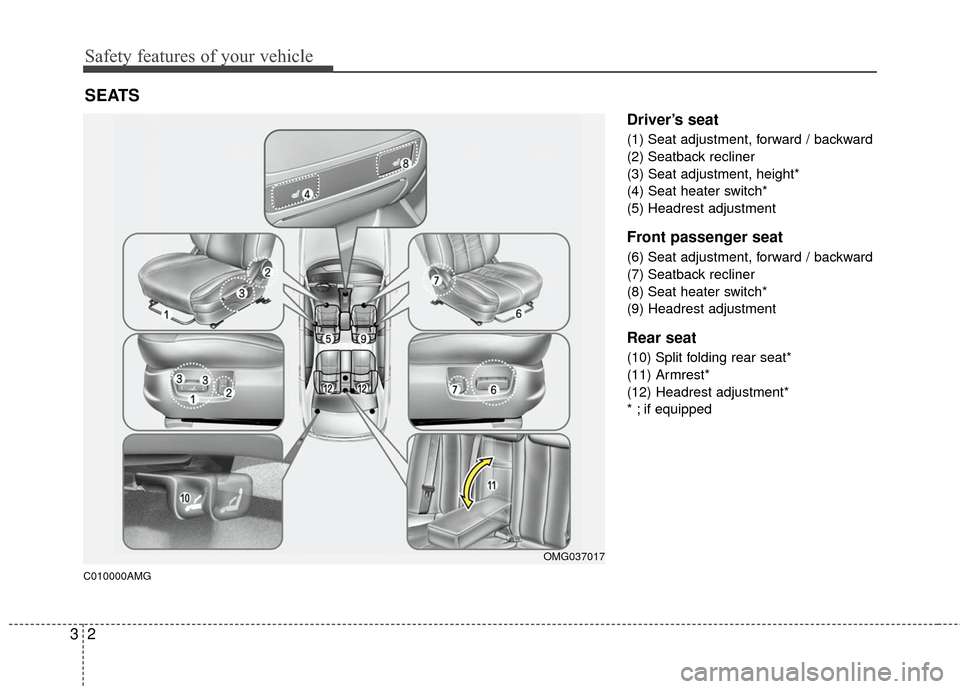
Safety features of your vehicle
23
C010000AMG
Driver’s seat
(1) Seat adjustment, forward / backward
(2) Seatback recliner
(3) Seat adjustment, height*
(4) Seat heater switch*
(5) Headrest adjustment
Front passenger seat
(6) Seat adjustment, forward / backward
(7) Seatback recliner
(8) Seat heater switch*
(9) Headrest adjustment
Rear seat
(10) Split folding rear seat*
(11) Armrest*
(12) Headrest adjustment*
* ; if equipped
SEATS
OMG037017
Page 17 of 336
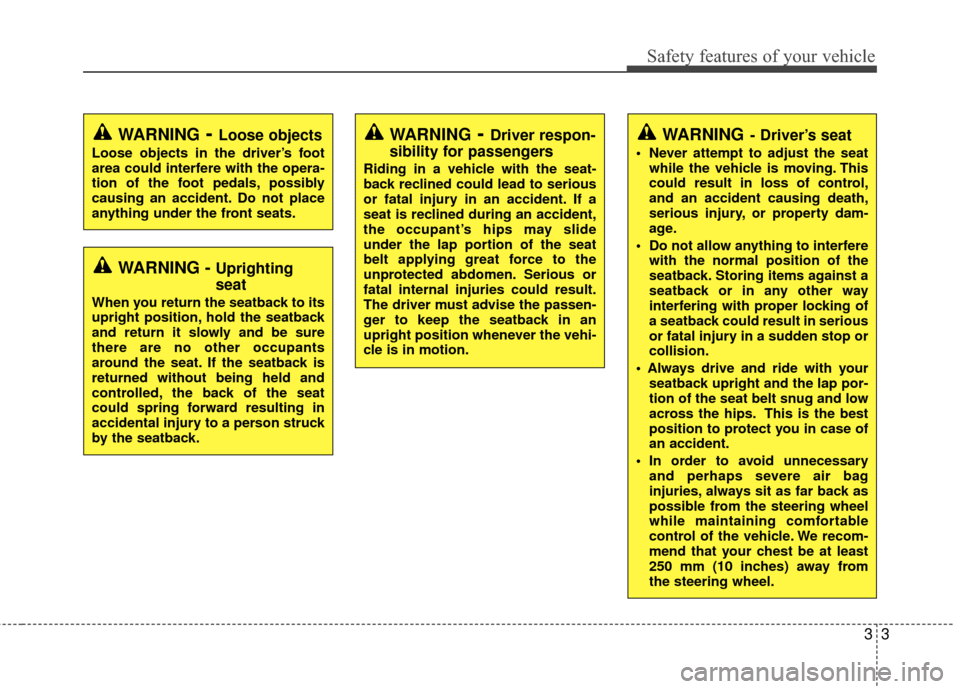
33
Safety features of your vehicle
WARNING- Driver’s seat
Never attempt to adjust the seatwhile the vehicle is moving. This
could result in loss of control,
and an accident causing death,
serious injury, or property dam-
age.
Do not allow anything to interfere with the normal position of the
seatback. Storing items against a
seatback or in any other way
interfering with proper locking of
a seatback could result in serious
or fatal injury in a sudden stop or
collision.
seatback upright and the lap por-
tion of the seat belt snug and low
across the hips. This is the best
position to protect you in case of
an accident.
In order to avoid unnecessary and perhaps severe air bag
injuries, always sit as far back as
possible from the steering wheel
while maintaining comfortable
control of the vehicle. We recom-
mend that your chest be at least
250 mm (10 inches) away from
the steering wheel.
WARNING- Loose objects
Loose objects in the driver’s foot
area could interfere with the opera-
tion of the foot pedals, possibly
causing an accident. Do not place
anything under the front seats.
WARNING- Driver respon-
sibility for passengers
Riding in a vehicle with the seat-
back reclined could lead to serious
or fatal injury in an accident. If a
seat is reclined during an accident,
the occupant’s hips may slide
under the lap portion of the seat
belt applying great force to the
unprotected abdomen. Serious or
fatal internal injuries could result.
The driver must advise the passen-
ger to keep the seatback in an
upright position whenever the vehi-
cle is in motion.
WARNING - Uprighting
seat
When you return the seatback to its
upright position, hold the seatback
and return it slowly and be sure
there are no other occupants
around the seat. If the seatback is
returned without being held and
controlled, the back of the seat
could spring forward resulting in
accidental injury to a person struck
by the seatback.
Page 18 of 336
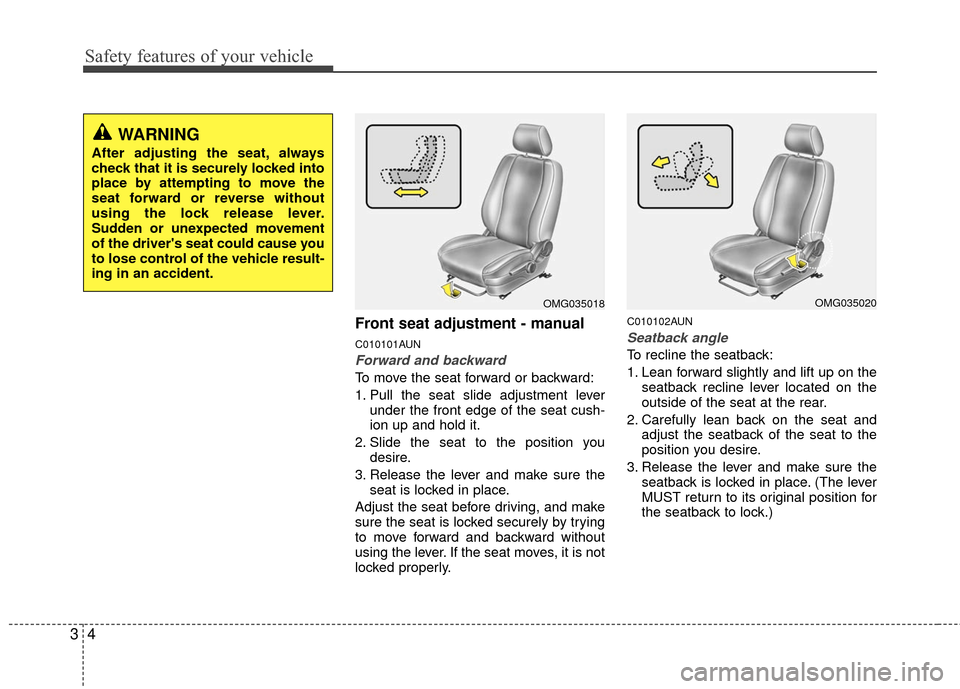
Safety features of your vehicle
43
Front seat adjustment - manual
C010101AUN
Forward and backward
To move the seat forward or backward:
1. Pull the seat slide adjustment leverunder the front edge of the seat cush-
ion up and hold it.
2. Slide the seat to the position you desire.
3. Release the lever and make sure the seat is locked in place.
Adjust the seat before driving, and make
sure the seat is locked securely by trying
to move forward and backward without
using the lever. If the seat moves, it is not
locked properly.
C010102AUN
Seatback angle
To recline the seatback:
1. Lean forward slightly and lift up on the seatback recline lever located on the
outside of the seat at the rear.
2. Carefully lean back on the seat and adjust the seatback of the seat to the
position you desire.
3. Release the lever and make sure the seatback is locked in place. (The lever
MUST return to its original position for
the seatback to lock.)
OMG035020OMG035018
WARNING
After adjusting the seat, always
check that it is securely locked into
place by attempting to move the
seat forward or reverse without
using the lock release lever.
Sudden or unexpected movement
of the driver's seat could cause you
to lose control of the vehicle result-
ing in an accident.
Page 19 of 336

35
Safety features of your vehicle
C010103AUN
Seat cushion height (for driver’s seat)(if equipped)
To change the height of the seat cushion,
push the lever that is located on the out-
side of the seat cushion upwards or
downwards.
• To lower the seat cushion, push down the lever several times.
To raise the seat cushion, pull up the lever several times.
C010104AMG
Headrest
The headrest not only provides comfort
for the driver and front passenger, but
also helps to protect the head and neck
in the event of a collision.
OMG035019
WARNING
For maximum effectiveness incase of an accident, the headrest
should be adjusted so the middle
of the headrest is at the same
height of the center of gravity of
an occupant's head. Generally,
the center of gravity of most peo-
ple's head is similar with the
height of the top of their eyes.
Also, adjust the headrest as close
to your head as possible. For this
reason, the use of a cushion that
holds the body away from the
seatback is not recommended.
Do not operate the vehicle with the headrests removed as severe
injury to the occupants may
occur in the event of an accident.
Headrests may provide protec-
tion against neck injuries when
properly adjusted.
Do not adjust the headrest height while the vehicle is in motion.
OBH038075L
Page 20 of 336

Safety features of your vehicle
63
Active headrest (if equipped)
The active headrest is designed to move
forward and upward during a rear impact.
This helps to prevent the driver's and
front passenger’s head from moving
backward and thus helps prevent neck
injuries.Forward and backward adjustment
(if equipped)
The headrest may be adjusted forward to
3 different positions by pulling the head-
rest forward to the desired detent. To
adjust the headrest to it’s furthest back-
wards position, pull it fully forward to the
farthest position and release it. Adjust the
headrest so that it properly supports the
head and neck.Adjusting the height up and down
To raise the headrest, pull it up to the
desired position (1). To lower the head-
rest, push and hold the release button (2)
on the headrest support and lower the
headrest to the desired position (3).
HNF2041-1OMG035026OMG035025